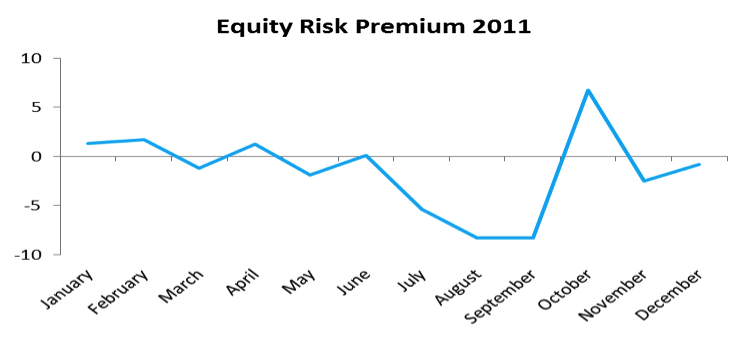Equity Risk Premiums (ERP) Determinants Estimation and Implications The 2011 Edition
Post on: 7 Май, 2015 No Comment

Equity Risk Premiums (ERP): Determinants, Estimation and
Page 2
ssrn.com/abstract=1769064
Equity Risk Premiums (ERP): Determinants, Estimation and
Implications
Equity risk premiums are a central component of every risk and return model in finance
and are a key input into estimating costs of equity and capital in both corporate finance
and valuation. Given their importance, it is surprising how haphazard the estimation of
equity risk premiums remains in practice. We begin this paper by looking at the
economic determinants of equity risk premiums, including investor risk aversion,
information uncertainty and perceptions of macroeconomic risk. In the standard approach
to estimating equity risk premiums, historical returns are used, with the difference in
annual returns on stocks versus bonds over a long time period comprising the expected
risk premium. We note the limitations of this approach, even in markets like the United
States, which have long periods of historical data available, and its complete failure in
emerging markets, where the historical data tends to be limited and volatile. We look at
two other approaches to estimating equity risk premiums – the survey approach, where
The notion that risk matters, and that riskier investments should have higher
expected returns than safer investments, to be considered good investments, is both
central to modern finance and intuitive. Thus, the expected return on any investment can
be written as the sum of the riskfree rate and a risk premium to compensate for the risk.
The disagreement, in both theoretical and practical terms, remains on how to measure the
risk in an investment, and how to convert the risk measure into an expected return that
compensates for risk. A central number in this debate is the premium that investors
demand for investing in the ‘average risk’ equity investment, i.e. the equity risk
premium.
In this paper, we begin by examining competing risk and return models in finance
and the role played by equity risk premiums in each of them. We argue that equity risk
premiums are central components in every one of these models and consider what the
determinants of these premiums might be. We follow up by looking at three approaches
for estimating the equity risk premium in practice. The first is to survey investors or
managers with the intent of finding out what they require as a premium for investing in
equity as a class, relative to the riskfree rate. The second is to look at the premiums
earned historically by investing in stocks, as opposed to riskfree investments. The third is
to back out an equity risk premium from market prices today. We consider the pluses and
minuses of each approach and how to choose between the very different numbers that
may emerge from these approaches.
Equity Risk Premiums: Importance and Determinants
Since the equity risk premium is a key component of every valuation, we should
begin by looking at not only why it matters in the first place but also the factors that
influence its level at any point in time and why that level changes over time. In this
A Price for Risk
To illustrate why the equity risk premium is the price attached to risk, consider an
alternate (though unrealistic) world where investors are risk neutral. In this world, the
value of an asset would be the present value of expected cash flows, discounted back at a
risk free rate. The expected cash flows would capture the cash flows under all possible
scenarios (good and bad) and there would be no risk adjustment needed. In the real
world, investors are risk averse and will pay a lower price for risky cash flows than for
riskless cash flows, with the same expected value. How much lower? That is where
equity risk premiums come into play. In effect, the equity risk premium is the premium
that investors demand for the average risk investment, and by extension, the discount that
they apply to expected cash flows with average risk. When equity risk premiums rise,
investors are charging a higher price for risk and will therefore pay lower prices for the
same set of risky expected cash flows.
Expected Returns and Discount Rates
Building on the theme that the equity risk premium is the price for taking risk, it
is a key component into the expected return that we demand for a risky investment. This
expected return, is a determinant of both the cost of equity and the cost of capital,
essential inputs into corporate financial analysis and valuation.
While there are several competing risk and return models in finance, they all share
some common views about risk. First, they all define risk in terms of variance in actual
returns around an expected return; thus, an investment is riskless when actual returns are
always equal to the expected return. Second, they argue that risk has to be measured from
the perspective of the marginal investor in an asset, and that this marginal investor is well
diversified. Therefore, the argument goes, it is only the risk that an investment adds on to
a diversified portfolio that should be measured and compensated. In fact, it is this view of
individual market risk factors, and each factor has it own price (risk premium). Table 1
summarizes four models, and the role that equity risk premiums play in each one:
Table 1: Equity Risk Premiums in Risk and Return Models
Model Equity Risk Premium
The CAPM Expected Return = Riskfree Rate + BetaAsset














